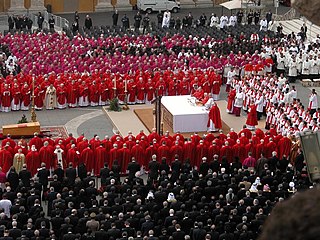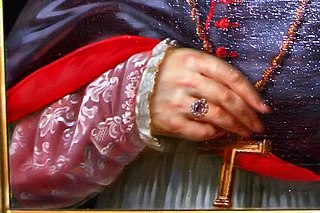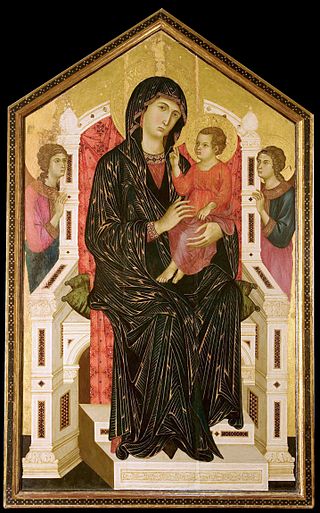Formal document emanating from the pope
A papal brief or breve (from the Latin "breve", meaning "short") is a formal document emanating from the pope.
 |
| Part of a series on the |
| Canon law of the Catholic Church |
|---|
| |
A papal brief or breve (from the Latin "breve", meaning "short") is a formal document emanating from the pope.
The introduction of briefs, which occurred at the beginning of the pontificate of Pope Eugene IV (3 March 1431 – 23 February 1447), was prompted by a desire for greater simplicity and expedition, such as had already been seen with the disappearance of the greater bulls and the general adoption of the less cumbersome mandamenta. A brief was a compendious papal letter which dispensed with some previous formalities. [1]
Briefs were written on vellum, generally closed, i.e., folded, and sealed in red wax with the papal Ring of the Fisherman. The Pope's name appears first and at the top, normally written in capital letters, e.g.: "PIUS PP III", and instead of the formal salutation in the third person used in papal bulls, the brief at once adopts a direct form of address, e.g., "Dilecte fili—Carissime in Christo fili", the phrase being adapted to the dignity and character of the addressee. The letter begins by way of preamble with a statement of the case and cause of writing and is followed by certain instructions without minatory clauses or other formulae. At the end the date is expressed by the day of the month and year with a mention of the seal, for example in this form: "Datum Romae apud Sanctum Petrum, sub annulo Piscatoris die V Marii, MDLXXXXI, pont. nostri anno primo". The year here specified, which is used in dating briefs, is probably to be understood in any specific instance as the year of the Nativity, beginning 25 December. However, Herbert Thurston (1908) noted that this is not an absolute rule, arguing that "the sweeping statements sometimes made in this matter are not to be trusted". In some instances the years meant are ordinary calendar years, i.e., years beginning with the first of January. [1]
A similar want of uniformity is generally observed in the dating of bulls from the middle of the eleventh century to the end of the eighteenth: Papal bulls were dated by the years of the Incarnation, commencing on 25 March, the Solemnity of the Annunciation. After the institution of briefs by Pope Eugene IV, the use of even lesser bulls, in the form of mandamenta, became notably less frequent. Still, for many purposes, bulls continued to be employed, for example in canonizations, in which case special forms are observed, the pope by exception signing his own name, under which is added a stamp imitating the rota as well as the signatures of several cardinals, as also in the nominations of bishops, promotions to certain benefices, some marriage dispensations, et cetera. But the choice of the precise form of instrument was often arbitrary. For example, in granting the dispensation which enabled King Henry VIII of England to marry his brother's widow, Catherine of Aragon, two forms of dispensation were issued by Pope Julius II, one a brief, seemingly expedited in great haste, and the other a bull which was sent on afterwards. Similarly we may notice that, while the English Catholic hierarchy was restored in 1850 by a brief, Pope Leo XIII in the first year of his reign used a bull to establish the Catholic episcopate of Scotland. So also the Society of Jesus, suppressed by a brief in 1773, was restored by a bull in 1818. [1]
Since the sixteenth century, briefs have been written in a very legible Roman hand upon a sheet of vellum of convenient size, while even the wax with its guard of silk and the impression of the fisherman's ring was replaced in 1842 by a stamp which affixed the same devices in red ink. The bulls, on the other hand, to the death of Pope Pius IX retained many medieval features apart from great size, leaden seal, and Roman mode of dating. In particular, although from about 1050 to the Reformation the writing employed in the Cancellaria Apostolica did not noticeably differ from the ordinary bookhand familiar throughout Christendom, the engrossers of papal bulls, even after the sixteenth century, continued using an archaic and very artificial type of writing known as "scrittura bollatica", with manifold contractions and an absence of any punctuation, which was practically undecipherable by ordinary readers. It was the custom in issuing a bull to accompany it with a "transsumption" (copy) in ordinary manuscript. This state of things was ended by a motu proprio of Pope Leo XIII shortly after his election: bulls were written in the same, legible Roman script that was used for briefs, and in view of the difficulties arising from transmission by post, the old leaden seal was replaced in many cases by a simple stamp bearing the same device in red ink. [1]
The "minutanti", being specialized Roman curials, employed in the preparation of briefs form a separate department under the presidency of a palatine cardinal styled the "Cardinal Secretary of Briefs" with the "Secretary of Latin Briefs and Briefs to the Princes", which office carried the dignity of prelate, as his substitute. [1]
When in the early 20th century the Secretariate of Briefs to Princes and of Latin Letters was placed under the direction of the Cardinal Secretary of State, the offices of this great department were transferred to the Apostolic Palace in Vatican City and established in the unoccupied halls of the old picture gallery, all on the same floor. The extent of business transacted there is evidenced by the archives. [1]
An abbreviator or breviator was a writer of the Papal Chancery who adumbrated and prepared in correct form Papal bulls, briefs, and consistorial decrees before these were written out in extenso by the scriptores.

The pope is the bishop of Rome and the visible head of the worldwide Catholic Church. He is also known as the supreme pontiff, Roman pontiff or sovereign pontiff. Since the eighth century, the pope has been the sovereign of the Papal States and later the Vatican City State. The current pope is Francis, who was elected on 13 March 2013.

Pope Boniface VIII was the head of the Catholic Church and ruler of the Papal States from 24 December 1294 until his death in 1303. The Caetani family was of baronial origin, with connections to the papacy. He succeeded Pope Celestine V, who had abdicated from the papal throne. Boniface spent his early career abroad in diplomatic roles.

A seal is a device for making an impression in wax, clay, paper, or some other medium, including an embossment on paper, and is also the impression thus made. The original purpose was to authenticate a document, or to prevent interference with a package or envelope by applying a seal which had to be broken to open the container.

A papal bull is a type of public decree, letters patent, or charter issued by a pope of the Catholic Church. It is named after the leaden seal (bulla) traditionally appended to authenticate it.

The College of Cardinals, more formally called the Sacred College of Cardinals, is the body of all cardinals of the Catholic Church. As of 8 June 2024, there are 236 cardinals, of whom 126 are eligible to vote in a conclave to elect a new pope. Cardinals are appointed by the pope for life. Changes in life expectancy partly account for historical increases in the size of the college.
An encyclical was originally a circular letter sent to all the churches of a particular area in the ancient Roman Church. At that time, the word could be used for a letter sent out by any bishop. The word comes from the Late Latin encyclios. The term has been used by Catholics, Anglicans and the Eastern Orthodox Church. Catholic social teaching has advanced 19 encyclicals.
Brief, briefs, or briefing may refer to:
Unigenitus is an apostolic constitution in the form of a papal bull promulgated by Pope Clement XI in 1713. It opened the final phase of the Jansenist controversy in France. Unigenitus censured 101 propositions of Pasquier Quesnel as:
false, captious, ill-sounding, offensive to pious ears, scandalous, pernicious, rash, injurious to the Church and its practices, contumelious to Church and State, seditious, impious, blasphemous, suspected and savouring of heresy, favouring heretics, heresy, and schism, erroneous, bordering on heresy, often condemned, heretical, and reviving various heresies, especially those contained in the famous propositions of Jansenius.

A papal conclave is a gathering of the College of Cardinals convened to elect a bishop of Rome, also known as the pope. Catholics consider the pope to be the apostolic successor of Saint Peter and the earthly head of the Catholic Church.

Papal regalia and insignia are the official items of attire and decoration proper to the Pope in his capacity as the visible head of the Catholic Church and sovereign of the Vatican City State.

The Ring of the Fisherman, also known as the Piscatory Ring, is an official part of the regalia worn by the pope, who according to Catholic theology is the head of the Catholic Church and successor of Saint Peter, who was a fisherman by trade. It used to feature a bas-relief of Peter fishing from a boat, a symbolism derived from the tradition that the apostles were "fishers of men". The Fisherman's Ring is a signet used until 1842 to seal official documents signed by the pope. Since at least the Middle Ages it has been a tradition for Catholics meeting the pope to show their devotion by kissing the ring.
The Secretariat of State is the oldest dicastery in the Roman Curia, the central papal governing bureaucracy of the Catholic Church. It is headed by the Cardinal Secretary of State and performs all the political and diplomatic functions of the Holy See. The Secretariat is divided into three sections: the Section for General Affairs, the Section for Relations with States, and, since 2017, the Section for Diplomatic Staff.
Apostolic expeditors are Roman Curial officials who attend to the sending of Papal Bulls, Papal Briefs and Papal Rescripts emanating from the Apostolic Chancery, the Dataria, the Sacred Paenitentiaria and the Secretariate of Briefs.
Ecclesiastical letters are publications or announcements of the organs of Roman Catholic ecclesiastical authority, e.g. the synods, but more particularly of pope and bishops, addressed to the faithful in the form of letters.

An ecclesiastical ring is a finger ring worn by clergy, such as a bishop's ring.
Quo primum is the incipit of an Apostolic constitution in the form of a papal bull issued by Pope Pius V on 14 July 1570. It promulgated the Roman Missal, and made its use obligatory throughout the Latin Church of the Catholic Church, except where there existed a different Mass liturgy of the Latin Church of at least two hundred years standing.
Papal diplomatics is the scholarly and critical study (diplomatics) of the authentic documents of the papacy, largely to distinguish them from spurious documents. The study emerges in the Middle Ages and has been further refined in the centuries since.

Mariological papal documents have been a major force that has shaped Roman Catholic Mariology over the centuries. Mariology is developed by theologians on the basis not only of Scripture and Tradition but also of the sensus fidei of the faithful as a whole, "from the bishops to the last of the faithful", and papal documents have recorded those developments, defining Marian dogmas, spreading doctrines and encouraging devotions within the Catholic Church.
A decretum laudis is the official measure with which the Holy See grants to institutes of consecrated life and societies of apostolic life the recognition of ecclesiastical institution of pontifical right. When the decree of praise is issued in the form of an apostolic brief, it is referred to as a 'brief of praise'.